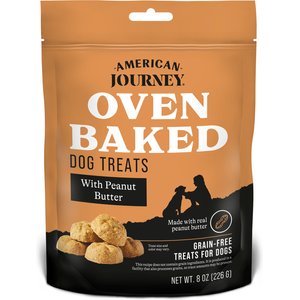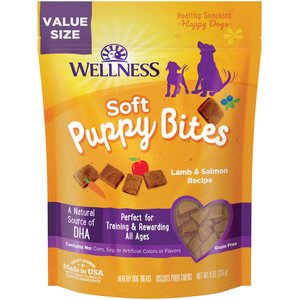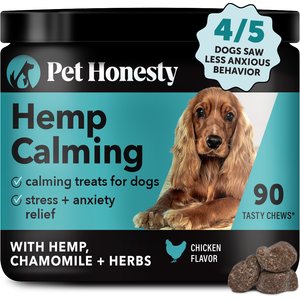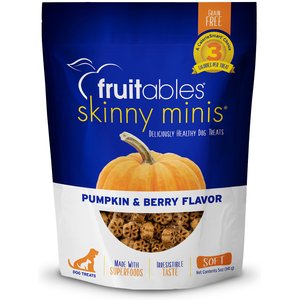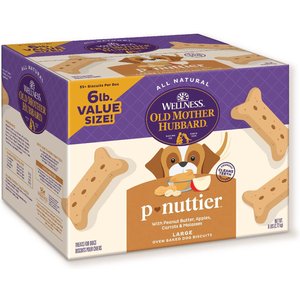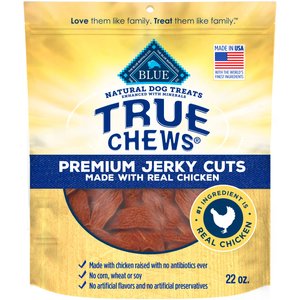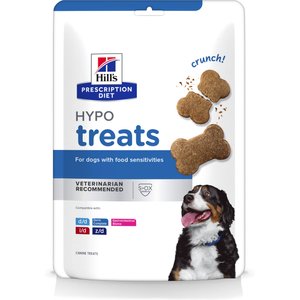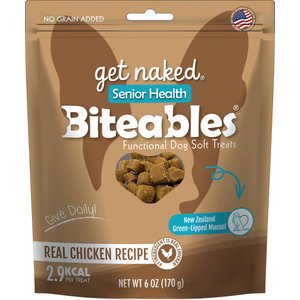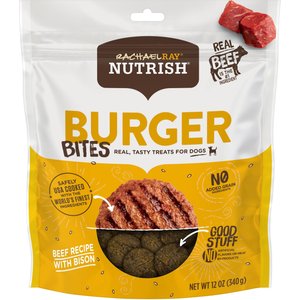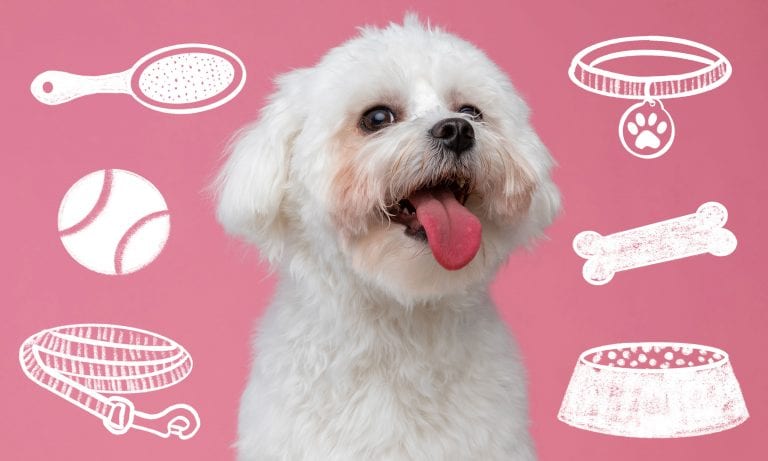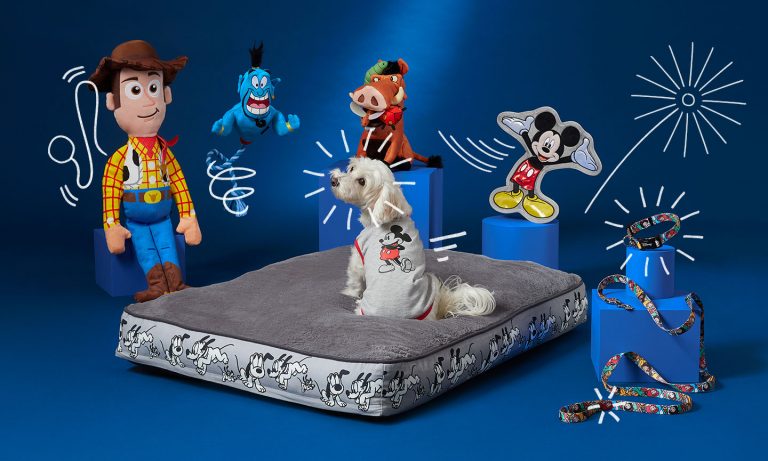It’s hard to tell who loves dog treats more: the pampered pups or the adoring pet parents.
It’s true: Everyone loves giving a Good Boy or Good Girl a snack! Additionally, treats can make training more exciting and rewarding. However, not all dog treats are created equal. As part of your dog’s diet, treats should be high-quality, wholesome and tailored to your individual pet’s needs. But remember, treats should never make up more than 10% of your furry friend's diet.
Looking for the best dog treats for your best friend? You’re in luck! We rounded up our most-loved dog treats—as chosen by pet parents like you—as well as expert advice for smart snacking.
-
1
Best Dog Treat OverallAmerican Journey Oven Baked Peanut Butter Biscuit Dog Treats, 8-oz bag $4 on Chewy
-
2
Best Dog Training TreatZuke's Mini Naturals Peanut Butter & Oats Training Dog Treats, 6-oz bag $6 on Chewy
-
3
Best Dog Treats for a PuppyWellness Soft Puppy Bites Lamb & Salmon Dog Treats, 8-oz pouch $10 on Chewy
-
4
Best Crunchy Dog TreatBlue Buffalo Health Bars Baked with Bacon, Egg & Cheese Dog Treats, 16-oz bag $5 on Chewy
-
5
Best Calming Treat for DogsPetHonesty Calming Hemp Chicken Flavored Dog Treats, 90 count $33 on Chewy
How to Find the Best Dog Treats
Dog treats have come a long way since one-size-fits-all biscuits. Not sure where to start? Here, Ashly Smith, DVM, a Lorton, Virginia-based veterinarian at Small Door Veterinary, shares what to consider when shopping for your four-legged friend:
- Your veterinarian’s advice: When making changes to your dog’s diet, it’s always a good idea to consult your veterinarian. They can recommend trusted treats that are ideal for your pup’s needs.
- Your reason for treating: Why are you giving your dog a treat? Select a treat that’s appropriate for the purpose. For example, when training, choose small treats that you can give multiple times; for dental hygiene, select treats designed to help keep teeth clean.
- Your dog’s size: Make sure to purchase treats that are appropriate for your dog’s size and jaw strength.
- Your dog’s health needs: Consider your dog’s overall health when selecting treats, including food sensitivities, digestive issues and dental concerns. Remember, treats are part of your dog’s diet and should be selected as carefully as the main meal.
- Your pet’s caloric needs: Treats should not exceed 10% of your dog’s daily calories. If you are unsure about your pet’s caloric needs, consult your veterinarian. “Owners should always check in with their vet for a recommended daily calorie intake so they can proportion their meals and treats appropriately,” Dr. Smith says.
12 Best Dog Treats
Below are the best dog treats as tested and approved by Chewy customers. These top-selling, top-rated dog treats get two paws up from dog parents like you.
Best Dog Treat Overall
-
Made in America
Not only made in america but baked. I am very happy with these treats and my pups love them. A double plus
-
They’re not messy or crumbly, they just seem fresh.
My dogs LOVE these treats. I use them as their “high value “ treats, and they don’t upset their stomachs.
-
My dogs jumped for joy!
Every time I get this treat bag out, my dogs jump and dance and can hardly wait until I give them a treat. They obviously taste delicious
Best Dog Training Treat
-
My dog loves these treats.
He’s 15 yrs old and has developed a sensitive tummy so I have to watch what and how many treats he’s allowed . They’re soft and small so he thinks he hit the jackpot when he gets more than one at a sitting..ha ha ha.
-
Size and taste
My dog loves puzzles and these treats are the perfect size to put in the small holes in the puzzles
-
Dessert treat!
My dog loved the peanut butter treats! She's 10 pounds and has teeth issues and was easy for her to chew and digest.
Best Dog Treats for a Puppy
-
Taste!
He loved the flavor, but unfortunately isn’t able to eat them anymore, but he loved these soft chews!! 10/10 recommend!!
-
Soft and flavorful
My dog loves these treats. They are soft, very flavorful (apparently, since she gobbles them up, and a perfect size for my dog. I can easily break them in half to make them more economical. So half of 1-2 are good reward for her standing still for some extra grooming.
-
Pomsky puppy loves them
My new puppy really likes these i use them when I cut his nails and they really distract him! Very good would recommend!
Best Crunchy Dog Treat
-
Health Bars
Small dog (20#) seems to enjoy them, but they are rather large for him. He'll only eat half and save the rest for later.
-
House Favorite
my dog likes all the flavors. he ate these when he was sick and wouldnt eat anything else. we break them in half since they are generously sized.
-
Health bars
My dog heard a bird say bacon pancakes and now demands a bacon pancake biscuit for breakfast, and she loves this so much that she will take her medicine chews as long as i put all together in a toy like its a treat
Best Calming Treat for Dogs
-
Grieving dog
My 7yr old Great Dane lost her brother and was experiencing separation anxiety when we would even leave the room. I started giving her these, she still has some issues but it is not as severe.
-
This appears to be working
Check out the weight, your dog needs to be over 20 pounds, which our three month old Rotty is far beyond. Either his training and age is making a difference of this stuff really works. I just ordered another small bag to see if the affect keeps going. I give it to him right after breakfast, when he turns into a baby alligator with the zooms before we can get our first good walk completed. It doesn't zonk him. He is a little over 30 pounds and just turned three months.
-
They work
I have a 70 pound 9 month old Saint Bernard puppy and it helps for his separation anxiety. I have only ever given him 2 a day.
Best Dog Dental Treat
-
What a hit!
My pup adores these so much. I cut one serving into pieces and dole them out in a few days. Otherwise, eating one whole one gets her a little chubby. So give them sparingly.
-
They work great!
These are by far the best dental chews I’ve gotten for my dog. She loves them and they actually work :)
-
No more stinky breath!
This product is amazing. My pups get one every other day and their breath doesn't stink and their vet comments on how clean their teeth look and they are 8 years old. Greenies save me money because the pups never need dental work. Great product and the dogs LOVE their Greenies!
Best Dog Treats for Small Dogs
-
Small, healthy treats
Since my fur baby is small, I am glad to have a treat she loves that is small and healthy for her.
-
Loved them!
I sent these treats to my niece’s dog Jack and she told me they were a big hit! I had sent Jackie a snuffle mat sometime ago and apparently these Skinny Mini’s work perfectly for hiding in the mat!
-
My Fur baby loves them
My little guy absolutely loves Fruitables line! I personally like them cuz they low calorie an mini bites for the little chubbiers in the family
Best Dog Treats for Large Dogs
-
My dogs love this
My dogs love these as treats every morning to start their day off. I cut them up and give them a half treat each day.
-
A Product with Natural Ingedients
My dogs' like these big bones as a treat. I like the bones because they seem to have natural ingredients without any harmful products added.
-
Dogs Don’t Lie
Both of my dogs love these treats and devour them quickly. Especially my GSD! I like them because they are so much healthier than the Milk Bone treats I’ve given them in the past.
Best Natural Dog Treat
-
Blue Jerky chews
My dogs really like these jerky treats. I use to give them another brand they liked but it was discontinued. I bought Blue Jerky chews to replace the other brand.
-
These are loved even from a picky eater.
I give these treats ONLY when we leave the house and need to put Chloe in her crate. She sees one of these and literally runs to her crate! Perfect.
-
A welcomed treat since day 1.
When we picked up our Yorkie as a tiny 8 week old puppy we were give a few pieces of Blue Buffalo True Chews Chicken Jerky treats. Our Yorkie still loves them and never hesitates to do her training so she can get more of these treats.
Best Dog Treats for Sensitive Stomachs
-
Peanuts only dog treats
He gets his bones because he loves him and they’re healthy for him and he is a happy, healthy little dog and that makes me happy!
-
My dog loves them
My dog has tons of allergies and is allergic to most treats. These must taste good because he loves them and is excited every time.
-
Hydrolyzed protein treats
My Tibetan Terrier has severe reactions to many proteins, so these hydrolyzed protein treats are so appreciated by her and by us!!
Best Dog Treats for Senior Dogs
-
Another winner
This is a perfect bedtime treat for my senior Havanese who has problems with his teeth. They are small and soft enough for him to consume. He gets about 6 every night.
-
Small and plentiful
My dog loves to eat quick instead so bite size treats are perfect to give my dog many at a time lasts a while when she eats treats so quick lol
-
Senior dog treats
Very happy for these treat for my toothless senior dog. Her younger brother gets treats so she wants some too and this is a great option!
Best Soft Dog Treats
-
Yummy to their tummy
My dogs get one of these every night before bed, so they know it’s bedtime and the last time they come in from going outside to do their business, they stand by the jar. They love these !
-
Great treats for my boy!
My boy Diesel is 12 and missing quite a number of teeth. He loves these treats - they are easy for him to chew!
-
My picky dog loves them!
The quality and my dog’s preference for her treats. She’s very picky but has loved every Rachael Ray treat we’ve purchased!
How We Chose These Products
Treats are a fun way to bond with your pet and reinforce good behavior. That’s why we rounded up Chewy’s best-selling dog treats and selected only those that have at least a 4-star rating from satisfied Chewy customers. Backed by hundreds of ratings and reviews, each of these bestsellers are beloved by dogs and dog parents alike.
Types of Dog Treats
What type of treat fits your four-legged friend? From puppies to seniors, playtime to bedtime, there’s a biscuit for every bud.
Training
When training, treats are a great way to reward your dog with positive reinforcement, keeping sessions fun and exciting. However, it’s important to keep calories in mind, which is why training treats tend to be small and low-calorie.
Best for: training exercises; situations where multiple treats will be offered
Crunchy
Crunchy biscuits are classics, and they’ll never go out of style. When dogs chew on crunchy treats, the hard texture helps to remove plaque, stimulate the gums and improve dental health, says Dr. Smith. Crunchy treats tend to be lower in calories than soft options, and many pups enjoy the engaging textures.
Best for: dental hygiene; managing weight
Soft
Just like crunchy treats, soft treats offer unique benefits. Pliable and easy to break into smaller pieces, they can be great for portioning out during training sessions. Soft treats can be easier to chew for dogs with missing teeth and also tend to be highly palatable, says Dr. Smith, making them ideal for picky eaters and pets struggling with appetite.
Best for: breaking apart; dogs who have trouble chewing harder textures; dogs with little appetite
Natural
Natural dog treats are made using minimal ingredients, and contain no artificial colors, flavors or preservatives. While every pet can benefit from clean, high-quality ingredients, says Dr. Smith, natural treats are especially helpful for dogs with food sensitivities, as they contain few ingredients.
Best for: pets with food restrictions; ingredient-conscious pet parents
Dental Treats
Dental treats can help keep your pup’s teeth cleaner, gums healthier and breath fresher. Dental chews are shaped to “scrub” plaque away, and have a crumble-resistant texture that prevents new debris from becoming trapped in the teeth and along the gumline. However, Dr. Smith stresses that they’re not a substitute for regular dental care and cleanings.
Best for: dogs who need a dental hygiene assist; freshening breath
Puppy Treats
Treats designed for puppies are small, soft and squishy–just like puppies! The petite portions make them perfect for puppy training, and the soft texture is ideal for dogs still developing jaw strength.
Best for: training puppies
Senior Treats
Senior dog treats are softly textured for aging jaws, and may contain supplements such as glucosamine and chondroitin to support joint health and other age-related concerns. These treats also tend to be highly palatable, making them ideal for older dogs who have medical conditions that may affect appetite, such as cancer.
Best for: older dogs; dogs who struggle with appetite and/or jaw strength
Calming Treats
For pups who need help relaxing, calming treats may help manage symptoms of stress. They can be especially helpful during anxiety-producing situations. To help you select the best calming treat for your pet, consult your veterinarian and/or certified dog trainer or animal behaviorist.
Best for: helping dogs manage stressful situations
Tips for Feeding Dogs Treats
Everyone enjoys treat time! However, remember that dog treats are part of your pet’s diet, and should receive the same care and consideration as dog food. With that in mind, consider these tips from Dr. Smith.
- Monitor your pet’s weight. Obesity can have serious effects on your pup’s health, so watch the scale and portion appropriately to ensure treats don’t exceed 10% of your pet’s daily diet. “It’s important to be mindful of portion sizes and incorporate treats into your dog’s daily calorie intake accordingly,” says Dr. Smith. “Always check in with your vet for a recommended daily calorie intake so you can proportion meals and treats appropriately.”
- Be mindful of ingredients. Just like meals, treats should be healthy. “Opt for high-quality treats made with wholesome ingredients to ensure they contribute to your dog’s overall nutrition,” says Dr. Smith.
- Divide larger treats as needed. “When it comes to training, using small, bite-sized treats can be helpful in preventing overfeeding while still providing positive reinforcement,” says Dr. Smith. “You can also break larger treats into smaller pieces to make them last longer during training sessions.”
- Think outside the biscuit box. Food isn’t the only type of reward for good behavior. “Consider using alternative rewards such as praise, toys or playtime to vary the reinforcement and reduce reliance on treats,” says Dr. Smith. “Non-food rewards such as extra attention, walks or games can also be effective in reinforcing positive behaviors without adding extra calories.”
- Substitute dog-safe veggies. To mix things up and conserve calories, consider the produce section. “You can use vegetables like carrots or green beans as low-calorie snacks,” says Dr. Smith. See what other vegetables dogs can eat. (Always check with your vet before feeding human food, or any homemade dog food or treat.)
Talk to Your Veterinarian
Every dog is an individual, and what works best for your dog may not work best for another. Before introducing new pet food or treats to your dog’s diet, talk with your veterinarian about your pet’s health needs, caloric intake and weight concerns. Together, you can make sure treat time is, indeed, a treat.
Dog Treat FAQs
Q: What are high-value treats for dogs?
A: High-value dog treats are exciting snacks that dogs will work extra hard to earn. Helpful for training, these treats tend to be highly palatable, chewy and—sorry, pet parents!—extra smelly.
Q: What ingredients should I look for in healthy dog treats?
A: When shopping for healthy dog treats, look for wholesome, whole-food ingredients such as chicken, salmon or beef, and those that don’t contain fillers, additives, artificial preservatives, colors and flavors. Keeping portion control in mind, and select small treats or treats that can be easily broken apart.
Q: Can you freeze dog treats?
A: Freezing dog treats can help them taste fresher for longer. Keep the treats in the original packaging and place the package in an airtight freezer container. Before giving your dog a treat, allow it to defrost; frozen treats may be too hard and can damage your pet’s teeth. Even when frozen, treats should not be kept past the expiration date on the packaging.
Dog Treats Next Steps
Providing treats is one of the most fun parts of pet parenting. And when you select healthy, high-quality products, it’s even more rewarding. After all, your best friend deserves the best.
Curious to learn more about healthy portion control? Check out our expert guide and discover how much you should be feeding your dog.
Expert input provided by Ashly Smith, DVM, a Lorton, Virginia-based veterinarian at Small Door Veterinary.
This content was medically reviewed by a veterinarian.
Get more advice on feeding dogs:
Share:

